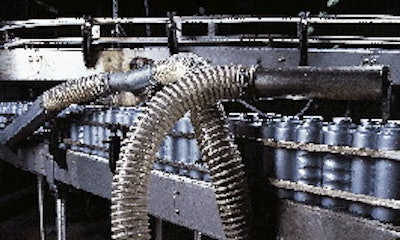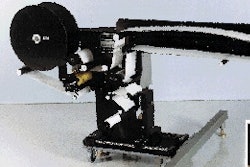The gorgeous gravure-printed shrink label graphics that have come to characterize Arizona Beverages' containers have been an effective, if costly, method of container decoration. Until now, all of the containers have been labeled by the container manufacturer. That has changed with the Sport Can. To eliminate the packaging line stresses experienced by a prelabeled container, FV&S has chosen to apply the label in the bottling plant near the end of the line. The Intersleeve shrink sleeve applicator, available through American Fuji Seal (Bardstown, KY) is one of three such applicators in the plant (two are on lines that package other Arizona products). Together the three applicators are the first Fuji/Intersleeve units to be installed in a bottling plant in North America. Until now, these machines have been used solely by bottle manufacturers, confirms Bill Hernandez, machinery sales manager for Intersleeve. Though the machines are rated NEMA 4X for harsh or wet environments such as beverage bottling plants, according to Hernandez, modifications were required to bolster the conveyor. Labeling before capping Ordinarily, it's preferrable for labeling to be the last step before case packing to minimize the potential for label damage, according to Rick Page, operations vp at New Wave Beverage, where the product is contract-packaged. But the shrink tunnel could cause heat buildup in the overcap, potentially popping it off. That's why labeling of the Sport Can container occurs prior to capping, itself the last step before case packing. On the packaging line, however, the containers must be "bone dry," according to Page, before they can be labeled. "If the container is wet the shrink label will ripple," he explains. Drying is assisted by two new air blowers on the line from Sonic Air (Brea, CA). One is positioned at the exit of the cooling tunnel for initial drying, and a subsequent blower is placed downstream after containers travel on about 75' of conveyor towards labeling. Before the containers can be labeled, they must be properly oriented, since graphics on the shrink sleeves must be coordinated to the molded grip on the back of the container. To assist with orientation, Owens-Brockway molds the containers with a notch on the bottom. As containers are conveyed on the packaging line, they constantly rotate until the notch catches a small rail placed on the conveyor infeed to the labeler, which locks the containers into the proper orientation. Once oriented, a pre-heating station heats up the container surface to ensure a better shrink application. Meanwhile the layflat label tubestock unwinds through a series of rollers to a mandrel that opens up the tube of film. A registration mark on the film triggers a photoeye to signal the machine to cut off an individual sleeve. That label is then dropped down over the container as it moves through the labeler. "It goes down fairly hard over the container because of the speed," says Page. "It's not an intermittent machine," he notes, though he does say each container pauses for a brief instant to ensure that the label is perfectly centered over the container. Since there is almost no room for error, the machine's PLC maintains the necessary critical timing. Immediately after the sleeve is dropped, a series of fingers then tap the sleeve down to make sure it's as low as possible. In the heat tunnel, also from American Fuji, trial and error was needed to get the label to shrink around the grip molded into the container, according to Page. "We had to come up with a formulation in building the heat up and coming back down again without burning the plastic, because if you create too much heat it can create little pinholes throughout the label," says Page. Though Page says the labelers will operate at about 150/min on the cans, they currently run at the 90/min line speed that's limited by the capper. Another feature of the labeler is fast changeover. According to Page, it takes only about 10 minutes to change to the 20- and 16-oz glass bottles of Arizona products that the line also runs. However, Page says the speed is due in part to modifications made by New Wave. After labeling, containers pass through the homemade seal tester that checks the inner seals for leaks (see main story). Containers that pass the test are immediately capped with push-pull and overcap closures. The capper is a rebuilt rotary unit that was brought in as a temporary measure. If volume demands increase, says Page, New Wave will look for a capper that will bring the line up to the 150 bpm speed of the labelers.


























